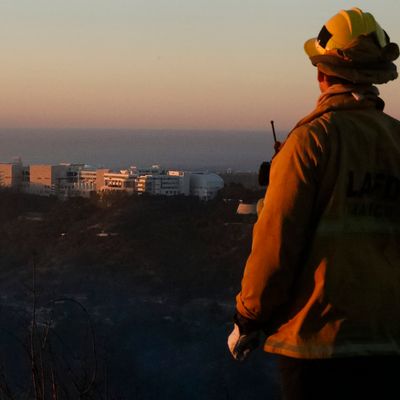
By all accounts, Los Angeles’s J. Paul Getty Trust, the world’s largest cultural and philanthropic organization dedicated to the visual arts, has been having a banner year. In addition to leading the charge on Pacific Standard Time: LA/LA, a citywide exploration of Latin-American and Latino art in conjunction with L.A. galleries and institutions from Pasadena to Venice, the Getty Center was preparing to celebrate its 20th anniversary with Robert Polidori: 20 Photographs of the Getty Museum, 1997, a suite of voyeuristic images capturing the first exhibition at the Richard Meier–designed museum, which sits atop a hill overlooking the 405 freeway separating Brentwood from Bel Air.
But that celebration may have to wait — these days, the hills along the 405 are on fire. In the early-morning hours on Wednesday, the museum, which houses an art and antiquities collection of global importance, was put on high alert when a brush fire on the east side of the freeway started engulfing homes in the hills of Bel-Air. “Our concern always is if the wind would blow embers across the freeway and land on our property,” says Ron Hartwig, vice-president of communications at the Getty, who notes that as soon as they were alerted to the fire hazards, the ground crew turned on the irrigation system. “Our slopes are very wet right now. All day yesterday and through the night the irrigation system was on to keep the planting closest to the Getty well-dampened. And, of course, we have a very aggressive ongoing brush-clearance program to remove as much combustible material from around the Getty as possible.”
The museum’s central garden is marked by a precise, ravine-bisected arrangement of more than 500 plant species (including London plane trees, rebar-directed bougainvillea arbors, a bowl garden full of kangaroo paw, a pool of Kurume azaleas, and a sloped lawn, which visitors are invited to roll down) designed by Cool School artist Robert Irwin. It is not only a work of art but one of the most visited attractions in all of L.A.
“The people who did the landscaping were really quite savvy and plants with the highest water content are closest to the buildings and as they move away they get more into the native habitat,” says Hartwig, noting the Getty also has a one-million-gallon water tank to irrigate and suppress fires as needed. Last night, 50 staffers were on an all-night fire watch — while playing host to LAPD and LAFD officers in need of food, water, and shelter when they weren’t battling the flames — to spot (and snuff out) any embers that floated across the freeway. “We went through the night well. Everything is calm here and for the moment at least the winds are blowing in a way where we don’t even have that much smoke,” adds Hartwig, who was watching the winds shift this morning from his 405-facing office windows. “They appear to be going more east.”
While much of the concern yesterday was about whether the museum would move the art and artifacts in the Getty’s encyclopedic collection, Hartwig insists the museum is the safest place for these treasures due to the the institution’s fire-resistant travertine hardscaping and a high-tech air-filtration system. “A normal air-conditioning system it pulls air in to keep recirculating, but in a situation like this where you don’t want to pull smoke with all of the harmful carbon and ash, you reverse it so you’re pressurizing the buildings to force air out rather than allowing it in,” explains Hartwig. “On top of that there’s what is called a dry-pipe sprinkler system — the pipes are literally dry, they have no water in them — and they’re not activated by heat necessarily; it takes a series of switches and procedures to get them turned on in the out chambers of the galleries and then, ultimately, the galleries.”
For Hartwig, in addition to the round-the-clock efforts of local police and firefighters — who have kept the Skirball fire relatively contained given how thin resources have been stretched with the Ventura fire — credit goes to Meier and his team of engineers who seemed to have built a museum that may very well be impervious to the rising threats of global warming.
“Their number-one priority in designing this building was to withstand disasters like fires and earthquakes, because it’s on top of a hill in a native environment and it’s not entirely accessible,” says Hartwig, noting the museum will remain closed at least through tomorrow, depending on when the smoke clears. “Our concern is really for our neighbors across the freeway who really got the brunt of all of this. We were very lucky. Somebody asked me yesterday, ‘Are you worried?’ I said, ‘We’ll be worried until the last ember is out.’ Cautious optimism is the watchword today.”





























